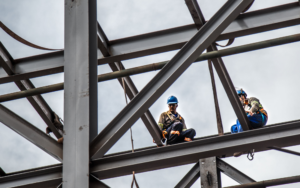Annual Salary: $75,710 (Structural Iron & Steel Workers)* 
*Average annual compensation for a craft worker in Wisconsin.
Source: U.S. Department of Labor, Bureau of Labor Statistics, May 2022
Description
Structural Iron Workers erect the steel framework for large industrial, commercial, or residential buildings, bridges, and metal tanks. They erect, bolt, rivet, or weld the fabricated structural metal members that support the structure during and after construction. Some iron workers, called rodmen, set steel bars (rebar) or steel mesh in forms to strengthen concrete buildings, bridges, and highways. Other iron workers, called Ornamental Iron Workers, install and assemble grills, canopies, stairways, iron ladders, decorative iron railings, posts, and gates.
Working Conditions
Iron workers work in crews, usually outdoors. Work is highly seasonal and dependent upon suitable weather conditions. They frequently work in high places and cramped quarters. There is considerable climbing, walking, sitting, and balancing on ladders and girders.
Aptitude and Interest
Iron workers must receive satisfaction from working with their hands. They must be able to work to rigid standards and fine measurements. They must have an acute awareness of dangers to both themselves and their co-workers. Also, ironworkers can not be afraid of work in high places.
Training
To become a skilled iron worker training is essential. It can be acquired informally through “learning-by-working;” through company on-the-job training programs; by attending trade or vocational/technician schools; through unilaterally (management or labor) sponsored trainee programs; through registered labor-management apprenticeship programs, or a combination of the above. It is generally accepted that the more formalized training programs give more comprehensive skill training. Recommended high school courses include English, general math, algebra, geometry, physics, mechanical drawing, and welding.